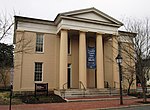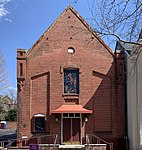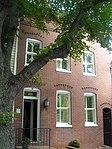Alexandria Historic District
Federal architecture in VirginiaGeography of Alexandria, VirginiaGeorgian architecture in VirginiaGreek Revival architecture in VirginiaHistoric districts in Northern Virginia ... and 7 more
Historic districts on the National Register of Historic Places in VirginiaHistory of Alexandria, VirginiaNRHP infobox with nocatNational Historic Landmarks in VirginiaNational Register of Historic Places in Alexandria, VirginiaNeoclassical architecture in VirginiaVictorian architecture in Virginia

The Alexandria Historic District is a National Historic Landmark District in Alexandria, Virginia. Encompassing all of the city's Old Town and some adjacent areas, this area contains one of the nation's best-preserved assemblages of the late-18th and early-19th century urban architecture. The district was declared a National Historic Landmark in 1966.
Excerpt from the Wikipedia article Alexandria Historic District (License: CC BY-SA 3.0, Authors, Images).Alexandria Historic District
Norton Court, Alexandria
Geographical coordinates (GPS) Address Nearby Places Show on map
Geographical coordinates (GPS)
| Latitude | Longitude |
|---|---|
| N 38.803333333333 ° | E -77.046388888889 ° |
Address
Downtown Baptist Church
Norton Court
22314 Alexandria
Virginia, United States
Open on Google Maps









